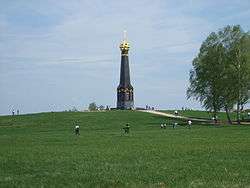Borodino (village), Mozhaysky District, Moscow Oblast
Borodino (Russian: Бородино́) is a rural locality (a village) in Mozhaysky District of Moscow Oblast, Russia, located 13 kilometers (8.1 mi) west of Mozhaysk.
Borodino | |
|---|---|
Village | |
 Borodino | |
| Coordinates: 55°32′N 35°49′E | |
| Country | |

.png)
The village is famous as the location of the Battle of Borodino on 7 September 1812[1] in the Napoleonic Wars during the French invasion of Russia. The Borodino Battlefield (Бородинское поле) is now part of the State Borodino War and History Museum and Reserve. The reserved area is 109.7 square kilometers (42.4 sq mi); the area of the protected zone is 645 square kilometers (249 sq mi).
History
Archaeological evidence suggests that the area around Borodino was settled around 500 BC by Finnish, and then Slavic tribes. The well-preserved earthworks of a fort dating from about 200 BC, located near the village of Gorki, represent the earliest known military-historical construction in the Borodino area. However, the earliest written mention of the village of Borodino that has been found was in the 17th century.
Borodino's lands were attached to the Moscow principality at the beginning of the 14th century and were at the boundary with Lithuanian territory along the old Smolensk road. The peasants farming the land cultivated winter rye, spring barley, oats, summer wheat, flax, hemp and buckwheat. The farms were assessed as "fair" to "average". Women, except for field work, were engaged in spinning flax and wool, weaving and knitting, for home use. During the Time of Troubles the area suffered from bandits and raiders, and even until the end of the 18th century much of the area was still abandoned.[2]
According to some reports the hamlet of Borodino was first mentioned in the Mozhayskie scribe books in 1601. During the Time of Troubles the village was described as having a "churchyard on the Tsar's sovereign land on the Voinka River (река Воинка) with the Church of the Exaltation of the Cross of the Lord and the chapel of St. Nicholas",[3][4] and further "in the church, images and candles and books and every church structure had secular parishioners".[5]
Prior to the construction of its own church at Borodino, people from the district were parishioners of the church of the Exaltation of the Holy Cross, which was on the other side of the Kolocha River at the confluence of the Stonets and Prudki creeks.[6] This church with a chapel (the lower church) in honor of St. Nicholas, Archbishop of Myra was destroyed in the Time of Troubles, probably in 1609. After that, the locals were parishioners in the church of the Assumption in the village Semenov also having a lower chapel of St. Nicholas.[6] The news of this church terminated in the middle of the 17th century.
Since the beginning of the 17th century, the village was known as the first possession of the Russian Tsar Mikhail Fedorovich Romanov dynasty, which after 1613 was presented to them as the "Czar of Tsarevo salary" "yastrebniku" (position in the "tsar's hunting") Mozhayskoe policeman nobleman. Theodore Konoplev Konopleva son Basil, who owned the neighboring hamlet - Shevardino. He belonged to the old servitors, whose members are mentioned in the documents of the end of the 16th century.
In 1626 and 1627, the area is referred to in the letter Mozhayskie scribe books and measures Nikifora Neplueff clerk and Alexei Berestov as "the place of the church, fields overgrown forest", and in fact Borodino, as seltso Kolotsky mill of Mozhaysk County. Then half of the village of Borodino - "The yard of his place votchennikovo yes four places peasant serfs" was recorded for Bogdan Kanaplyou Vasilyevich, 1595-1598 in which he was the elder labial and had a yard to Mozhajsk and the other half - the 'four Peasants and bobylskih place "for his cousin (according to other sources - a nephew), Dmitry Mikhailovich Kanaplyou. The village gave them Fedor cannabis in exchange for the contribution given by his brother Bogdan Fedoseyev (after tonture Thedore) in Pafnutyevo-Borovsky monastery.
During the 1941 Battle of Moscow, the field was the place of a severe clash between the Soviet and German forces.
Notes and references
- 26 August in the Julian calendar then used in Russia.
- Gorbunov, Alexander V. [Горбунов, Александр В.]. Здесь, на полях Бородина… (in Russian). The State Borodino Military History Museum-Reserve. Archived from the original on 4 April 2017. Retrieved 3 April 2017.
- сельского поселения Бородинское [Rural settlement of Borodino] (in Russian). Administration of Borodino Official Website. Archived from the original on 15 March 2017. Retrieved 3 April 2017.
- Смоленский храм (in Russian). Moscow Diocese of the Russian Orthodox Church. Archived from the original on 31 March 2017.
- Gorbunov, Alexander V. [Горбунов, Александр В.]. Село Бородино как объект культурного наследия (in Russian). The State Borodino Military History Museum-Reserve. Archived from the original on 5 March 2016.
- История деревни Бородино [History of the village of Borodino] (in Russian). BankGorodov. Archived from the original on 12 August 2016.
Sources
- Official website of the State Borodino War and History Museum and Reserve (in English and Russian)
- The celebration of the centennial anniversary of Victory in the Patriotic war of 1812. Emperor Nicholas II on Borodinsky celebrations 1912.